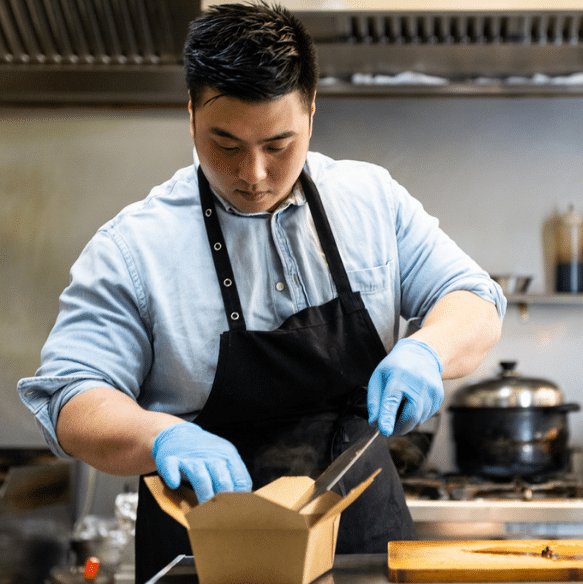Sign up for restaurant insights
Loyal diners are the best diners… but why? Restaurant loyalty programs act as both an incentive and a data-generating tool, helping owners and operators better understand consumer behavior while also giving diners a reason to make another reservation or order that pizza supreme for the fifth week in a row.
Loyal customers reduce the need to appeal to and convert new customers, a costly endeavor. Statistics also show that your chances of selling to a new customer are a so-so 5%-20% while the chances of selling to an existing customer are 60%-70%.
Add to all that an increase in online promos brought on by the digital age and the mindfulness with which diners spend their hard-earned wages in this post-pandemic world and there’s a major realization to be had: The way you connect with customers and keep them engaged could be what makes or breaks your business.
How do you build a restaurant loyalty program?
The tech-driven nature of modern restaurants and third-party delivery services means that diners are always just a few clicks away from their next meal. For restaurants, it’s increasingly important to find ways to not only snag the attention of new customers but to keep that attention once those customers are on board.
Loyalty programs support your restaurant marketing strategy by offering members ways to accumulate points, access special rewards, and take advantage of discounts. Every offer you send is an opportunity. Even if recipients don’t act on a promo, you’ve made a connection and kept your restaurant name, cuisine, and general concept top of mind.
Here are a few things to keep in mind when creating your own restaurant loyalty program:
- How will it drive revenue? Your rewards program and the incentives it includes should be designed to increase traffic and boost revenue, so it’s important that every promo meets that standard.
- POS Compatibility: Not all rewards programs work with every POS system, and you’ll want the tech support as membership grows. That’s the only way you can efficiently and accurately track points, redeem rewards, and track that revenue/cost.
- How will the program work? You want your rewards program to be easy for the guest to use and exciting enough that guests will want to use it. Work out the details before you launch and ensure guidelines are fair, clear, and available for review/reference at any time (on your website, perhaps).
- Who will do the day-to-day management? Someone will need to be in charge of setting up the campaign, managing customer service, overseeing email marketing, and tracking/acting on analytics.
- Is it robust and flexible enough to be more than a discount program? Discounts are just one aspect of an appealing and effective rewards programs. You’ll want more than basic functionality so your program has room to grow.
- Who owns your data and how do you get it if you exit/want to transition to a new provider? Make sure you can get your data (member info, point tallies, etc.) from your chosen provider if you decide to switch platforms.
- What are the direct (guest facing) communication channels? Decide which channels you’ll want to use (email, push notifications, SMS, etc.) and compare that to the features offered by potential program partners.
Pros & cons of loyalty programs
Time and time again, research shows solid correlations between customer loyalty and increased revenue, with rewards programs further boosting those numbers.
Consider these loyalty statistics:
- 43% of customers will spend more on brands they’re loyal to
- Decreasing your churn rate (customer turnover) by 5% can lead to an overall increase in profitability of 25%-125%
- When deciding between brands, 75% of consumers will choose the brand that has a loyalty/rewards program for its members
- Over 70% of consumers say they’d be more likely to recommend a particular brand if that brand also had a solid loyalty program.
Even with all that in mind, restaurant owners and operators know that capturing diners’ attention and keeping them engaged can be harder than it looks. That’s why we created the dynamic promotions and loyalty tools included in the Grubhub Direct dashboard.
Whether you’re considering signing up for Grubhub-supported restaurant rewards or just interested in more information about restaurant rewards programs in general, here’s a look at some top pros and cons.
Pros
- Own your guest data. Owning your guest data is important (it’s how you’ll have direct communication with guests once you go live with a new promo, for example) but some third-party delivery platforms tack on a fee for that “privilege.” With Grubhub Direct, our commission-free online ordering site, all customer data belongs to you — completely free of charge.
- Reward loyal guests. You probably already have regulars who stop by weekly or monthly, and you’re likely using your restaurant comp fund to throw them a few free drinks or appetizers as a thank you. Launching a restaurant rewards program formalizes that arrangement and expands upon it, giving you an opportunity to show guests your appreciation on a grander level.
- Opportunity to increase visits and check size. Studies show rewards programs can bring in bigger revenue for a couple reasons. Loyalty club members are 59% more likely to choose that brand over competitors. Consumers also tend to spend more when they’re racking up rewards, with 66% of survey respondents saying they modify the amount they spend in order to maximize points.
Cons
- The program is only part of the equation. The average consumer is enrolled in over 14 loyalty programs but actively uses less than half of those. It takes more than establishing a restaurant rewards programs to engage with customers and drive orders. You’ll have to invest time and resources in managing the program and developing exciting promos and rewards, too.
- Average discount per user can be high. If you’re giving every rewards customer a significant discount, those discounts can add up quickly and become detrimental to your profit margins. Discounts have to be given strategically and paired with efforts to increase check average to be beneficial to your bottom line.
- Data analysis can be costly and time-consuming. Your customer data can help you identify patterns of behavior you can then use to inform promotions, product development, decisions about store hours, and so on. But analyzing all that data can cost a lot of money if you have to outsource.
3 Restaurant loyalty programs that work
Not all rewards programs are created the same. Here are some promotions that can help you make your program a raging success.
Limited time offers
Diners typically love anything that’s considered fresh and new, and the hype of a limited-time offer could bring customers through the door — even if they were just there the other day.
- Introduce a menu item tied to a major national event like a sports championship or a majorly hyped awards show
- Try out a new seasonal menu with early access for loyalty program members (spiced-up fall latte, anyone?)
- Use National Food Holidays as inspiration, creating promos that tie into Apple Pie Day or National Kale Day — this could be a free menu item, a dollar off related apps, or free delivery for that day only
- Offer a time-restricted discount to help pump up orders during a known slow period, for instance offering free delivery on Tuesday, or a try a week of lunchtime discounts to introduce consumers to your new lunch menu
Special occasions
Use your customer data to recognize and reward customers on their special day. Send out targeted promos for birthdays and give out freebies like bonus points for signing up, referring members, or attending a special event.
Come-back campaigns
Combine existing customer appreciation ideas with come-back campaigns supported by your loyalty program and customer data. You can base campaigns off info such as when a customer’s last delivery order was, what time they usually order, or what their favorite meal is.
Examples of come-back campaign wording and incentives include:
- “We miss you” — reference that it’s been a while since the customer ordered and give them a reason (“Check out what’s new!” or “Here’s 10% off, just for you) to return.
- BOGO – “We know you love our tacos, so we want to give you more of them to enjoy. Here’s a buy one, get one offer, good for your favorite carne asada.”
- “We saw you liked our top-selling summer salad. Have you seen our newest versions for fall?”
Grow your loyal diners with Grubhub
The best restaurant rewards programs are those that give each restaurant what it needs to level up. Unique, restaurant-specific rewards and loyalty initiatives are more likely to get diners excited and help you address your pain points while increasing the likelihood of long-term success.
While setting up a new restaurant loyalty program may seem daunting at first, the results are well worth the investment.
Let Grubhub take some of the pressure off. Join Grubhub Direct to access a wealth of resources designed to help you with everything from crafting a branded customer experience to running tailored promotions emailed straight to your loyal fans.





